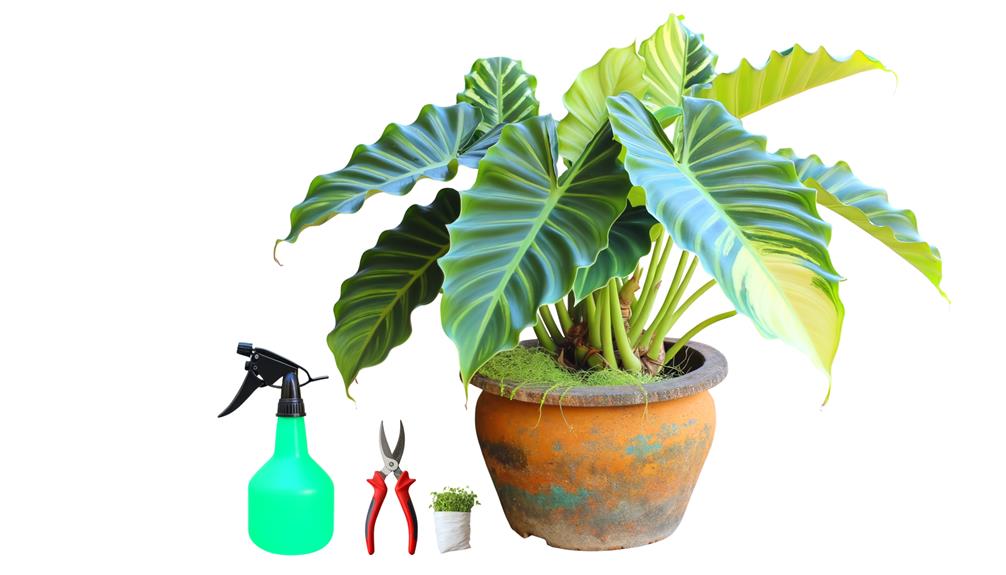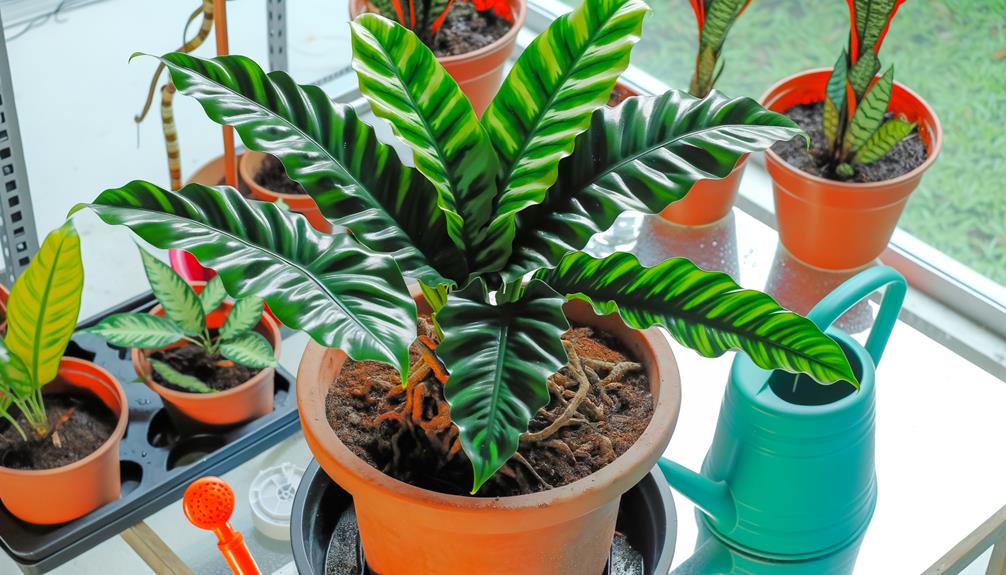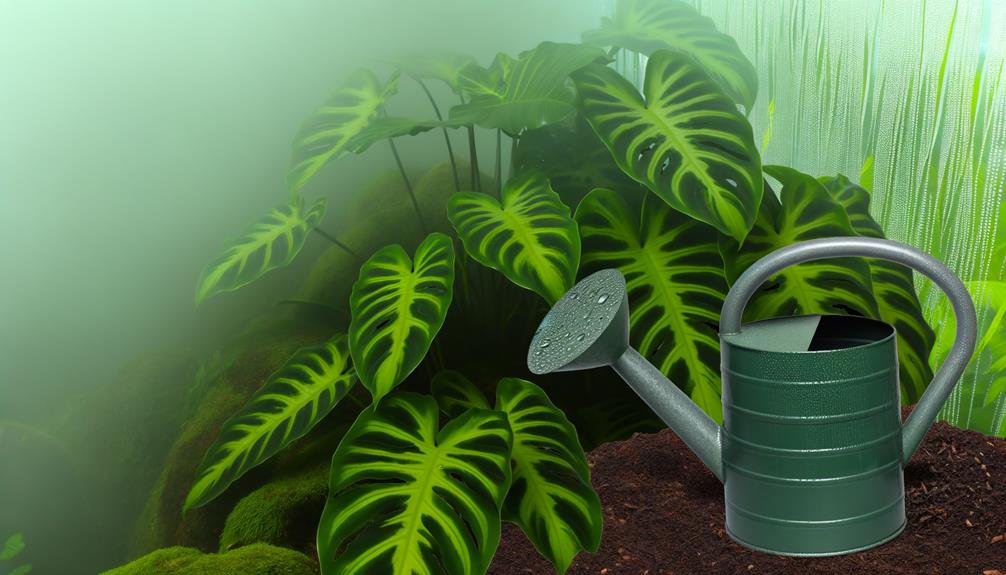Tiger Tooth Philodendron Care
The Tiger Tooth Philodendron (Philodendron bipinnatifidum) thrives in bright, indirect light and temperatures of 65-75ºF. It enjoys medium to high humidity and should be watered once every 7-10 days to maintain consistent soil moisture.
The plant can adapt to lower light conditions and prefers well-draining soil with a pH of 6.0-7.0. A balanced, water-soluble fertilizer applied monthly during the growing season supports healthy growth.
Be mindful of overwatering which can lead to root rot or pests such as spider mites. With further exploration, you'll master techniques to address these issues and maintain the plant's health.

Key Takeaways
- Tiger Tooth Philodendron thrives in bright, indirect light and a temperature range of 65-75°F.
- The plant should be watered every 7-10 days, ensuring the soil is moist but not waterlogged.
- Tiger Tooth Philodendron prefers medium to high humidity levels, ideally between 50-60%.
- A well-draining soil with a pH range of 6.0-7.0 is ideal, along with monthly application of balanced, water-soluble fertilizer during the growing season.
- Be vigilant against pests like spider mites and aphids, and treat with systemic insecticide if necessary.
Understanding Tiger Tooth Philodendron

The Tiger Tooth Philodendron, scientifically known as Philodendron bipinnatifidum, is a mesmerizing tropical plant renowned for its distinctive serrated leaves that strikingly resemble the teeth of a tiger. Originating from the rainforests of South America, this plant exhibits a robust growth habit, reaching up to 15 feet in height with a similar spread.
Its dark green, glossy leaves can measure up to 3 feet long, adding to its visual appeal. The plant's unique leaf structure is not only ornamental but also functional, facilitating efficient photosynthesis. The Tiger Tooth Philodendron is a dioecious species, meaning it has separate male and female plants.
The plant's reproductive strategy involves the production of an inflorescence, bearing both male and female flowers to facilitate pollination.
Ideal Lighting and Temperature Conditions
Moving on to the care requirements of the Tiger Tooth Philodendron, ideal lighting and temperature conditions play a pivotal role in the plant's growth and overall health. It thrives in bright, indirect light as direct sunlight can cause leaf burn. A north or east-facing window is recommended. However, it can adapt to lower light conditions, demonstrating its robust nature.
Concerning temperature, Tiger Tooth Philodendron prefers a range of 65-75°F (18-24°C). It can tolerate a minimum of 60°F (15°C), but prolonged exposure to colder temperatures may stunt growth or cause leaf damage. Avoid placing near drafts, air conditioning, or heating vents.
These conditions promote a healthy plant capable of serving its caretakers with its aesthetic and air-purifying qualities.
Watering and Humidity Preferences

In the world of plant care, watering and humidity levels hold immense significance, particularly for the Tiger Tooth Philodendron which displays specific preferences in these areas. This tropical plant thrives in medium to high humidity levels and prefers its soil to be consistently moist but never waterlogged. Overwatering can lead to root rot, a common issue among indoor plants.
Here's a simplified table summarizing the plant's watering and humidity preferences:
| Watering Frequency | Preferred Humidity Levels |
|---|---|
| Once every 7-10 days | Medium to High |
| Should be watered when the top 1-2 inches of soil feels dry | 50-60% is ideal |
| Avoid excessive watering, it can lead to root rot | Mist frequently during dry months |
| Water less often during winter | Use a humidifier if the air is too dry |
| Make sure there's good drainage to prevent waterlogging | Keep away from heat sources that reduce humidity |
Correct Soil and Fertilizer Use
Fostering robust growth in your Tiger Tooth Philodendron calls for a keen understanding of its soil and fertilizer needs, as these components play a central role in nutrient provision and overall plant health.
- Soil: This plant thrives best in well-draining soil. A mixture of peat, perlite, and coarse sand is ideal, providing necessary nutrients and facilitating proper aeration.
- pH Level: The ideal soil pH for this philodendron ranges between 6.0 and 7.0. Regular testing guarantees the soil remains within this range, promoting nutrient absorption and preventing root damage.
- Fertilizer: Use a balanced, water-soluble fertilizer. During growing season, apply monthly, while reducing to bi-monthly in dormant periods. Over-fertilizing can lead to root burn, so adherence to recommended quantities is essential.
Common Problems and Solutions

While correct soil and fertilizer usage greatly contribute to the health of your Tiger Tooth Philodendron, understanding and promptly addressing common plant problems also play a vital role in maximizing its strength and longevity.
Pests such as spider mites and aphids can infest your plant, causing damage that manifests as yellowing leaves or stunted growth. A systemic insecticide can effectively eliminate these pests.
Overwatering, meanwhile, leads to root rot and can be lethal to the plant. Ensure proper drainage and allow the soil to dry between waterings.
Nutrient deficiencies, particularly of nitrogen and magnesium, might result in discolored or pale leaves. Regular application of a balanced, slow-release fertilizer can rectify this issue.
Seek to identify and address these common problems swiftly for best plant health.
Conclusion
To sum up, proper care for a Tiger Tooth Philodendron involves meticulous attention to its lighting, temperature, watering, and soil requirements. Any deviation from the recommended parameters may lead to common plant problems.
However, with the right knowledge and application, this plant can thrive and flourish, becoming a verdant beacon in any indoor garden. Its lush leaves reflecting the fruitfulness of careful cultivation.






